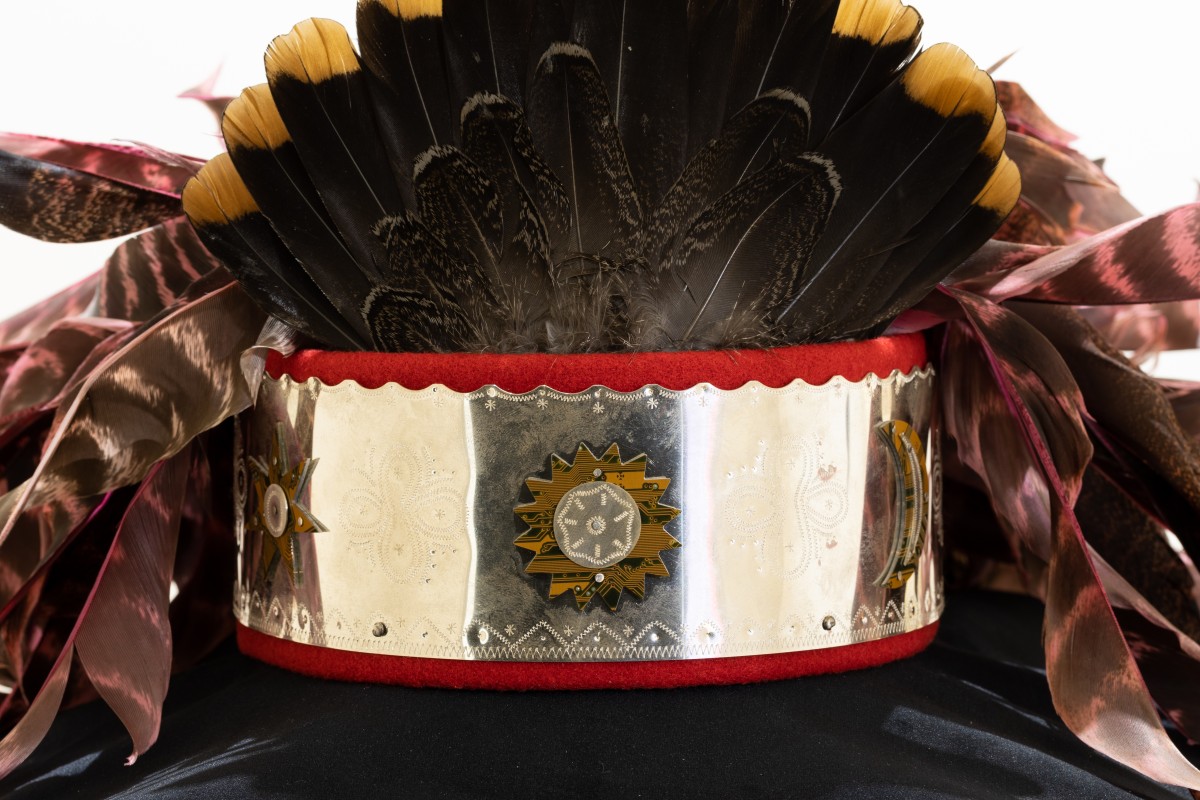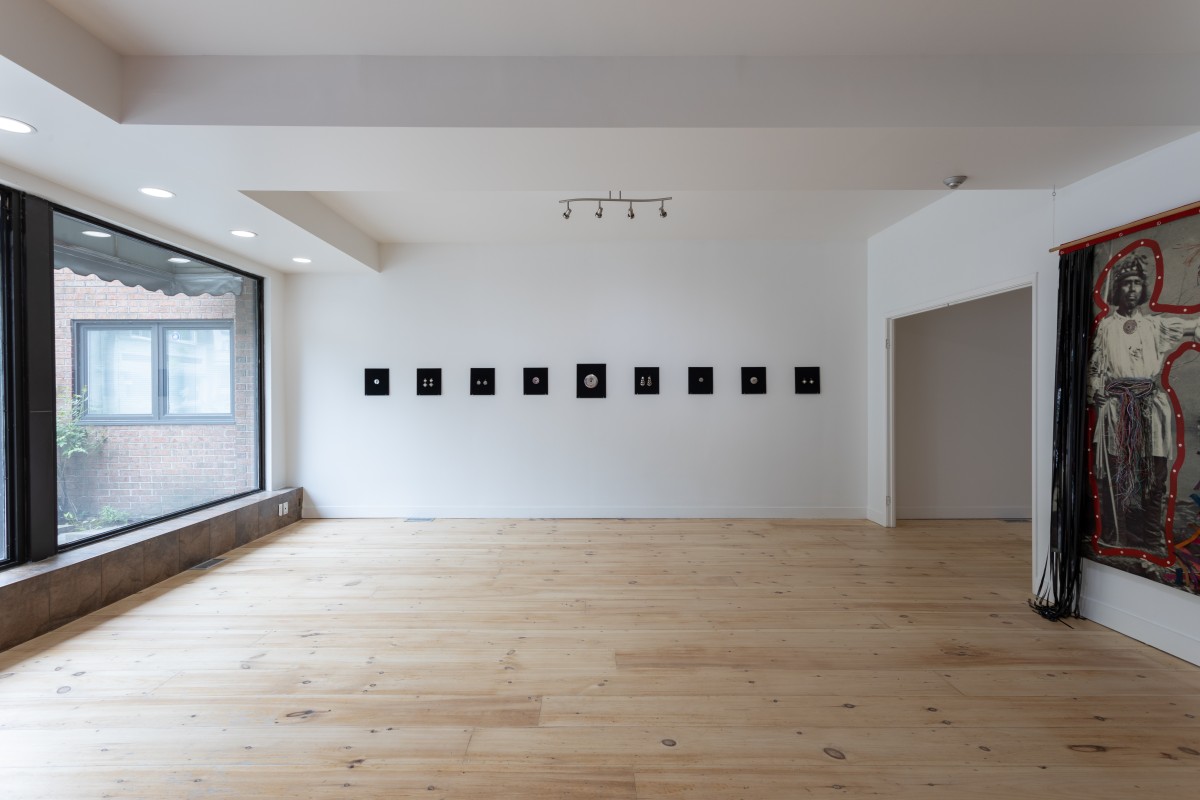Meet daphne
Montréal’s first Indigenous artist-run centre opens its doors with an exciting line-up of exhibitions.

Michel Savard, Untitled (2021), mixed media - silver, electronic components, wool stroud, feathers. Photo credit: Mike Patten.
Last May, Montréal welcomed its first Indigenous artist-run centre. Despite Quebec being home to nearly 60 artist-run centres, the city lacked a dedicated exhibition space for Indigenous artists and communities. No more. Inspired by pioneering Anishinaabe artist Daphne Odjig (1919–2016), who herself founded an Indigenous artist-run space in Winnipeg in 1971, daphne aims to be a safe space for Indigenous artists to present works, generate discussion, share cultures and strengthen relations.
Eager to learn more, we called daphne’s Executive Director, Lori Beavis, to chat about this exciting addition to the Montréal scene.
AGOinsider: daphne is the first Indigenous artist-run centre in Montréal! What sparked its beginnings and how did it come to fruition?
Beavis: In 2018, the four artist-co-founders, Hannah Claus, Skawennati, Nadia Myre and Caroline Monnet, began to meet, to bead and talk about art and artists. They decided the project of creating an Indigenous artist-run centre – something some of them had been considering for many years – was something they were ready to make happen. Centre d'art daphne was officially founded and established as a legal and financial entity on April 1, 2019.
In its first year, daphne was invited by Toronto’s A Space artist-run centre to curate an exhibition of Wendat artist Ludovic Boney’s work for the ImagineNative International Indigenous Film + Media Festival – Boney’s first exhibition outside of Quebec. This exhibition set the tone for our first year of programming.
In 2019, the co-founders applied for and received a project grant from the Canada Council, which enabled the four co-founders to create the first year of programming and hire a director – me! I was hired in March 2020 – just as the pandemic and the ensuing restrictions hit Montréal .
In some ways this was a very good thing – daphne was like a slow brew as we built the structures and put all the pieces into place and at the end of the year– we finally rented our space for January 1, 2021. Additionally, last year we were able to write a funding application for the Conseil des arts de Montreal and for the CALQ (Conseil des arts et des lettres du Quebec) – both of which we gratefully acknowledge as programming funders.
The year at home also gave space and time to more fully realize the exhibitions – the artists and curators that would come together in our first year of programming. These exhibitions were planned as four solo exhibitions with an emphasis on Quebec-based Indigenous artists because they are often left out of the conversations taking place within Indigenous art communities – both nationally and internationally.
AGOinsider: Why an artist-run centre and not just an art gallery? What about the ARC model is important?
Beavis: Since their inception, ARCs have played a defining role in the development of contemporary art practices in Canada. By providing a framework to showcase experimental and non-commercial art, ARCs have been vital to the development of new artistic practices. They have contributed to the expansion of critical discourse on contemporary art and very importantly, the artist-run centres often exhibited work by Indigenous artists from the 1970s–80s onwards.
What sets daphne in a unique position is that we are an Indigenous-determined artist-run centre.
This means:
- We place Indigenous experience at the forefront of everything we do
- daphne is an Indigenous-run space with an Indigenous board of directors
- daphne is a space that recognizes many constituencies, with an emphasis on Indigenous artists and their art practice. We will also work with Indigenous arts workers – curators and writers, and people working in other sectors
- Through the exhibition, programming and daily running of the art centre, daphne will prioritize the knowledge, protocols and methodologies of individual artists, Nations, and communities
- daphne is an accessible space for Indigenous artists at all stages of their career
- To create a gathering space where people come to see art and teach or learn new skills and to be together – to visit
- daphne is a place where people will build relationships with one another to gain knowledge.
AGOinsider: daphne has been holding virtual events since last December and recently just opened its doors with an in-person exhibition. How has the reception been from visitors? Did anything surprise you? Has a digital community been easy or hard to build?
Beavis: The reception to daphne has been delightful! We have had so many visitors since we opened our doors to our friends and supporters on May 8, 2021. We opened our space that day as we do with all our gatherings, with the Ohen:ton Kariwatekhwen – the Thanksgiving Address also known as the “words before all else”. This is usually a call and response, but at daphne, we usually have everyone read one of the 18 passages ending with “and now our minds are one”. Very spontaneously at our opening, we passed the printed words from person to person so that each could read a passage. This action and the song that followed, sung by Teharihulen Michel Savard, was a wonderful way to introduce ourselves to the public. I think it was also a fine way to suggest the path we are following at daphne.
As for our virtual events – we were very eager to begin programming and as we did not know what the coming months would bring, we just decided to begin our Thursday evening beading circle, daphne beads:perler/ parler in mid-December 2020. Like when you have a party, you really don’t know if anyone would come – but they did! We are gathering our friends and relations from across the country to come.
We love being able to visit with people that we haven’t seen face-to-face for more than a year. These evenings give us a chance to catch up, exchange news and information; we have listened to artists talk about their work and learned new beading techniques from others.
Whether it has been easy or hard – I am not certain but I do know that when we do begin to meet in- person again, we will need a large screen so our friends from across Turtle Island will be able to join via Zoom.
AGOinsider: What are the biggest challenges facing Indigenous artists in your city? What do you hope daphne can provide?
Beavis: We have worked really hard to follow the protocol of Anishinaabewaki – to ground ourselves in this place – especially by this grounding being in relation to our Indigenous selves and not within the context of colonial ideology.
At daphne, we are working to make our reason to be in existence about relationality – with people and with the place. We are working to strengthen our artistic community through orality, practice and process. And finally, we are finding ways to live within the context of what our families and our ancestors experienced and taught us. As we will draw on these experiences and knowledge as part of the skills we are also acquiring to create something new.
AGOinsider: Any upcoming exciting projects/exhibitions our readers should know about?
Beavis: In July, daphne is partnering with Winnipeg’s Harbour Collective to present a programme of short films created by Quebec-based Indigenous artists (July 14 – with GIV and ImagineNative).
Later that month, an exhibition of works by Ilnu artist Sonia Robertson, curated by Logan MacDonald, will examine the in-between worlds through installations and projections.
Later in autumn 2021, emerging artist Kaia’tanoron Dumoulin Bush, from Kahnawake, QC will present a new series of mixed media works. The exhibition is curated by Métis artist and scholar Sherry Farrell Racette and together they are examining women’s experience of identity and Indigeneity.
Finally, we will complete our first year of solo exhibitions with a video-based exhibition with the Atikamekw artist Catherine Boivin, from January to March 2022. Boivin is a young multidisciplinary artist who expresses herself in several artistic forms, from video and photography, to bring together her love of marathon running and Powwow dancing as each, in their own way, brings her into contact with the land.
To learn more about daphne, their programming and exhibitions, visit https://daphne.art/. Their second exhibition featuring Ilnu artist Sonia Robertson opens July 17. Also, check out the colouring card we made of Daphne Odjig’s painting Odjig Family; Father, Mother, Grandfather, Stanley, Daphne, Donald, Winnie, Xmas, Dec 25th (1986).


